Shortboards vs. Longboards: Finding Your Wave Style
In the world of surfing, the type of board you ride can dramatically shape your experience. Whether you’re carving through powerful waves or cruising along mellow breaks, the debate between shortboards and longboards is a classic one. Both have their strengths, and the right choice often comes down to your skill level, the type of waves you’re riding, and your personal style.
The Basics: What Sets Shortboards and Longboards Apart?
Shortboards and longboards are distinguished primarily by their size, shape, and how they perform in the water:
- Shortboards are typically under 7 feet long and designed for speed, agility, and high-performance maneuvers. They have a narrower nose and tail, often with a pointed tip and multiple fins for sharp turns.
- Longboards are 8 to 10+ feet long, with a rounded nose and a broader outline. They’re built for stability and smooth gliding, making them ideal for a more relaxed style of surfing.
The Case for Longboards
Longboards are often the go-to choice for beginners and surfers who enjoy a classic, laid-back approach. Here’s why:
- Stability and Ease of Use
The larger surface area of a longboard provides stability, making it easier to paddle, stand up, and maintain balance. This makes them a great choice for beginners or those looking to refine their technique. - Perfect for Small Waves
Longboards excel in smaller, slower waves. They allow surfers to catch waves earlier and ride them longer, making the most out of even mellow conditions. - Classic Moves
Longboards enable iconic surfing maneuvers like nose riding and cross-stepping. These elegant, flowing movements evoke the golden era of surfing and are a joy to watch and perform. - Versatility
While often associated with smaller waves, longboards can hold their own in larger surf when handled by an experienced rider. Their versatility makes them a staple in any surfer’s quiver.
The Case for Shortboards
For those seeking speed and adrenaline, shortboards are the ultimate tool. They’re best suited for intermediate to advanced surfers who want to push their limits. Here’s why they shine:
- High-Performance Maneuvers
Shortboards are built for quick turns, aerials, and sharp cutbacks. They’re the weapon of choice for surfers looking to perform dynamic tricks and showcase their skills. - Handles Bigger Waves
In powerful, steep waves, shortboards excel. Their smaller size and pointed nose allow surfers to drop into waves with precision and navigate tight pockets of energy. - Lightweight and Responsive
The reduced weight and size make shortboards highly responsive, allowing for faster reactions and more control in critical sections of the wave. - Progression-Oriented
While they can be challenging for beginners, shortboards encourage surfers to improve their technique, strength, and agility, offering a rewarding path for progression.
Choosing the Right Board for You
The decision between a shortboard and a longboard often comes down to a few key factors:
- Skill Level
Beginners typically benefit from the stability of a longboard, while advanced surfers may gravitate toward the performance capabilities of a shortboard. - Wave Conditions
If you’re surfing small, mushy waves, a longboard is your best bet. For hollow, fast-breaking waves, a shortboard is the ideal choice. - Personal Style
Do you prefer a relaxed, smooth ride or a high-energy, aggressive approach? Your surfing style will influence your board preference. - Fitness and Paddling Power
Longboards require less effort to paddle and catch waves, making them a better option for those with less experience or fitness. Shortboards demand more power and endurance.
The Best of Both Worlds: A Quiver Approach
Many surfers eventually build a quiver—a collection of boards for different conditions. A longboard for laid-back days and a shortboard for when the surf picks up ensures you’re ready for anything the ocean throws at you.
The Eternal Debate
Shortboards and longboards represent two distinct philosophies of surfing. Longboards embrace the art of flow and tradition, while shortboards are about progression and pushing boundaries. Neither is “better” than the other; they’re simply tools to express yourself in the water.
At the end of the day, the best board is the one that brings you the most joy. Whether you’re carving sharp turns on a shortboard or gracefully gliding on a longboard, every wave is an opportunity to connect with the ocean—and that’s what surfing is all about.
